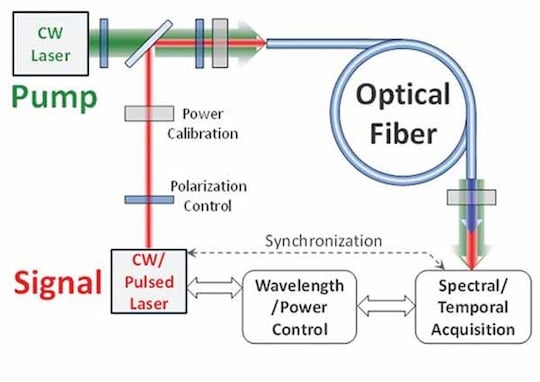This article is more than 1 year old
Three photons can switch an optical beam at 500 GHz
Watts the caper? More bandwidth, if the fibre is cooked just right
American photonics researchers have demonstrated an all-optical switching rig that can work at 500 GHz, controlling a beam using just three photons.
High-speed switching in the optical domain is important for several reasons: it will let optical networks outperform anything that can be accomplished if the photonic signal has to be turned into electrons to be switched, and it helps cut the voracious appetite for electricity in telecommunications networks.
It's the speed of the kit that the University of California, San Diego, scientists are trumpeting. In the article we've linked to, the university explains that you can't get such high speed switching without first being able to characterise the fibre down to the molecular level.
The team, led by professor Stojan Radic, developed techniques to measure “sub-nanometre” variations in the core of a fibre, measurements that let them manage dispersion even over long fibre lengths.

Schematic for UCSD's 500 GHz photonic switching scheme
With dispersion under control, the group was able to control a Watt-scale laser beam using just three photons – and with such a tiny control signal, they were able to get switching happening at 500 GHz.
The switching system needs silica fibre to work, because as Radic explains, it “represents a nearly ideal physical platform because of very low optical loss, exceptional transparency and kilometre-scale interaction lengths.”
To characterise the fibre, Radic's group recorded sub-nanometre core variations over many kilometres of fibre to build a “nanoscale signature library”. The release continues: “From there, they identified a specific core fluctuation profile that would correspond to the maximum depletion of the photon pump. Once the calculation yielded a unique core variation profile for a length of fibre, the scientists combined two distinct fibre sections from the core fluctuation library with the same variation profile.”
With the fibre so tightly characterised, Radic was then able to work out that a 178 nW pulse 2.5 picoseconds long – which equates to three photons – would be able to act as a control signal to switch the main beam at 500 GHz.
To turn this into a practical, commercial switch, Radic says, will need techniques to produce commercial quantities of engineered fibre that can be characterised as accurately as his team accomplished in the lab.
The work has been published in Science (abstract). ®
